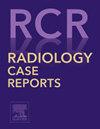孤立的外展神经受累是颞骨骨折的表现:1例报告
Q4 Medicine
引用次数: 0
摘要
孤立性外展神经麻痹是颞骨骨折的一种罕见但有临床意义的表现,通常发生在钝性头部创伤之后。我们报告的情况下,一个52岁的妇女谁维持一个右侧头部受伤后,在家庭跌倒在酒精的影响。她表现为复视、眩晕和右侧传导性听力丧失。临床检查显示右眼外展受损,异色伴流泪,右耳后淤血,上颌(V2)和下颌(V3)区域面部感觉减退。耳镜检查显示鼓室积血,测听显示60分贝传导性听力损失,镫骨反射缺失。电视震颤图显示右侧前庭功能缺损30%。高分辨率CT成像显示右颞骨纵向骨折,延伸至岩尖,伴包括髁脱位和鼓室积血。外展神经麻痹是由于外伤性拉伸或压迫多雷洛管附近,靠近岩脊。外科听骨成形术用于修复断裂的听骨链。本病例强调了对颅底创伤和脑神经麻痹患者进行细致影像学评估的重要性,特别是当影像学结果可以指导诊断和治疗方法时。本文章由计算机程序翻译,如有差异,请以英文原文为准。
Isolated abducens nerve involvement as a revealing sign of temporal bone fracture: A case report
Isolated abducens nerve palsy is an uncommon yet clinically significant manifestation of temporal bone fracture, often following blunt head trauma. We report the case of a 52-year-old woman who sustained a right-sided head injury after a domestic fall under the influence of alcohol. She presented with diplopia, vertigo, and right-sided conductive hearing loss. Clinical examination revealed impaired abduction of the right eye, anisocoria with mydriasis, right retroauricular ecchymosis, and facial hypoesthesia in the maxillary (V2) and mandibular (V3) territories. Otoscopy showed hemotympanum, and audiometry demonstrated a 60 dB conductive hearing loss with absent stapedial reflexes. Videonystagmography revealed a 30% vestibular deficit on the right side. High-resolution CT imaging showed a longitudinal fracture of the right temporal bone extending to the petrous apex, with associated incudomalleolar dislocation and hemotympanum. The abducens nerve palsy was attributed to traumatic stretching or compression near Dorello’s canal, in proximity to the petrous ridge. Surgical ossiculoplasty was performed to repair the disrupted ossicular chain. This case underscores the importance of meticulous imaging evaluation in patients with skull base trauma and cranial nerve palsies, particularly when radiological findings may guide both the diagnosis and therapeutic approach.
求助全文
通过发布文献求助,成功后即可免费获取论文全文。
去求助
来源期刊

Radiology Case Reports
Medicine-Radiology, Nuclear Medicine and Imaging
CiteScore
1.10
自引率
0.00%
发文量
1074
审稿时长
30 days
期刊介绍:
The content of this journal is exclusively case reports that feature diagnostic imaging. Categories in which case reports can be placed include the musculoskeletal system, spine, central nervous system, head and neck, cardiovascular, chest, gastrointestinal, genitourinary, multisystem, pediatric, emergency, women''s imaging, oncologic, normal variants, medical devices, foreign bodies, interventional radiology, nuclear medicine, molecular imaging, ultrasonography, imaging artifacts, forensic, anthropological, and medical-legal. Articles must be well-documented and include a review of the appropriate literature.
 求助内容:
求助内容: 应助结果提醒方式:
应助结果提醒方式:


